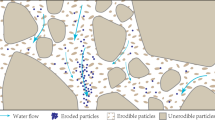Abstract
Internal erosion is a major cause related to nearly half of dam dysfunctions and failures. This phenomenon occurs when loose soil particles are transported outwards the soil mass by seepage through a series of pores and pore constrictions. As loose particles are usually fine and embedded in the pores formed by the soil primary fabric, traditional methods often correlate the representative sizes of fine and coarse particles to indicate the susceptibility to internal erosion of an assessed soil. These methods are not very accurate because soil particle size distribution can vary widely with several identical key sizes. This paper presents a new indicator for internal erosion assessment using the probability to be transported of loose particles: the segregation index. This index is estimated experimentally and analytically for the correlation with internal erosion test results. The index also has a significant role in the estimation of real effective stress of soils.
Access this chapter
Tax calculation will be finalised at checkout
Purchases are for personal use only
Similar content being viewed by others
References
Foster, M., R. Fell, and M. Spannagle, The statistics of embankment dam failures and accidents. Canadian Geotechnical Journal, 2000. 37(5): p. 1000–1024.
Bonelli, S., Erosion in geomechanics applied to dams and levees. 2013: John Wiley & Sons.
Fannin, R. and P. Slangen, On the distinct phenomena of suffusion and suffosion. Géotechnique Letters, 2014. 4(4): p. 289–294.
ICOlD, Bulletin 164 Internal erosion of existing dams, leeves and dikes, and their foundations. Vol. I: Internal erosion processes and engineering assessment. 2017, Paris: International Commission on Large Dams.
Goldin, A.L. and L.N. Rasskazov, Earth Dam Design. 2001: Изд-вo Accoц. cтpoит. вyзoв M.
Wan, C.F. and R. Fell, Assessing the potential of internal instability and suffusion in embankment dams and their foundations. Journal of Geotechnical and Geoenvironmental Engineering, 2008. 134(3): p. 401–407.
Burenkova, V., Assessment of suffusion in non-cohesive and graded soils. Filters in geotechnical and hydraulic engineering. Balkema, Rotterdam, 1993: p. 357–360.
To, P., A. Scheuermann, and D.J. Williams, Quick assessment on susceptibility to suffusion of continuously graded soils by curvature of particle size distribution. Acta Geotechnica, 2018. 13(5): p. 1241–1248.
Kenney, T., et al., Controlling constriction sizes of granular filters. Canadian Geotechnical Journal, 1985. 22(1): p. 32–43.
Indraratna, B., A.K. Raut, and H. Khabbaz, Constriction-based retention criterion for granular filter design. Journal of Geotechnical and Geoenvironmental Engineering, 2007. 133(3): p. 266–276.
To, H.D. and A. Scheuermann, Separation of grain size distribution for application of self-filtration criteria in suffusion assessment, in 7th International Conference on Scour and Erosion. 2014, CRC Press / Balkema: Perth, Australia. p. 121–127.
Indraratna, B., V.T. Nguyen, and C. Rujikiatkamjorn, Assessing the potential of internal erosion and suffusion of granular soils. Journal of Geotechnical and Geoenvironmental Engineering, 2011. 137(5): p. 550–554.
Kézdi, Á., Soil physics: selected topics. Vol. 25. 1979: Elsevier.
To, H.D., A. Scheuermann, and S.A. Galindo-Torres, Probability of Transportation of Loose Particles in Suffusion Assessment by Self-Filtration Criteria. Journal of Geotechnical and Geoenvironmental Engineering, 2016. 142(2): p. 04015078.
To, P. and A. Scheuermann. Suffusion assessment methods: A critical review. in International Conference on Scour and Erosion - 10. 2021. Arlington, Virgina.
Rochim, A., et al., Effects of hydraulic loading history on suffusion susceptibility of cohesionless soils. Journal of Geotechnical and Geoenvironmental Engineering, 2017. 143(7): p. 04017025.
Skempton, A. and J. Brogan, Experiments on pi** in sandy gravels. Geotechnique, 1994. 44(3): p. 449–460.
Homberg, U., et al. Determining geometric grain structure from x-ray micro-tomograms of gradated soil. in Workshop Internal Erosion.
To, H.D., S.A. Galindo-Torres, and A. Scheuermann, Sequential sphere packing by trilateration equations. Granular Matter, 2016. 18(3): p. 70.
Soddy, F., The kiss precise. 1936, Nature Publishing Group.
Silveira, A., T.d.L. Peixoto, and J.B. Nogueira, On void-size distribution of granular materials. 1975, SAO PAULO UNIV (BRAZIL).
Humes, C. A new approach to compute the void size distribution curves of protective filters. in Geofilters. 1996.
To, H.D., A. Scheuermann, and D.J. Williams. A new simple model for the determination of the pore constriction size distribution. in 6th International Conference on Scour and Erosion (ICSE-6). 2012. Société Hydrotechnique de France (SHF).
To, P., D. Agius, and L. Cussen, Influence of relative density of the granular base soil on filter performance. Acta Geotechnica, 2020. 15(12): p. 3621–3627.
Acknowledgements
The authors would like to express gratitude to Mr. Lewis Batic and Mr. Troy Poole for their invaluable help in setting up initial laboratory tests. Special thanks to the College of Science and Engineering, James Cook University for the financial help via the Research Infrastructure Block Grant.
Author information
Authors and Affiliations
Corresponding author
Editor information
Editors and Affiliations
Rights and permissions
Copyright information
© 2022 The Author(s), under exclusive license to Springer Nature Singapore Pte Ltd.
About this paper
Cite this paper
To, P., Le Van, T. (2022). Segregation Index—A New Soil Parameter for Internal Erosion Assessment. In: Ha-Minh, C., Tang, A.M., Bui, T.Q., Vu, X.H., Huynh, D.V.K. (eds) CIGOS 2021, Emerging Technologies and Applications for Green Infrastructure. Lecture Notes in Civil Engineering, vol 203. Springer, Singapore. https://doi.org/10.1007/978-981-16-7160-9_119
Download citation
DOI: https://doi.org/10.1007/978-981-16-7160-9_119
Published:
Publisher Name: Springer, Singapore
Print ISBN: 978-981-16-7159-3
Online ISBN: 978-981-16-7160-9
eBook Packages: EngineeringEngineering (R0)




